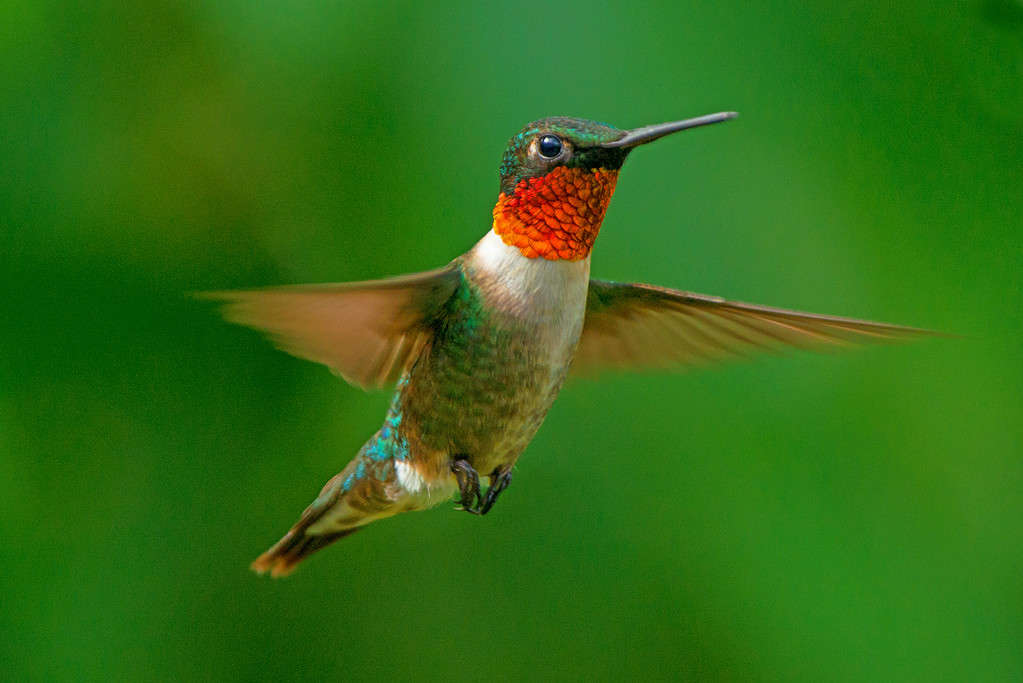Flowers blossoming, insects emerging, and birds returning north are among the first signs of spring. One of these birds is the beautiful hummingbird, which is seldom seen outside of the summertime. But why is this, and when will they come back? Let’s discuss why hummingbirds migrate and when locals can expect to see them back in Mississippi this spring.
Hummingbird Migration: a Brief Overview

Many hummingbirds don’t survive migration as this process can be very physically taxing.
©CarolinaBirdman/iStock via Getty Images
Even though some species of hummingbirds don’t migrate, such as Anna’s hummingbird, a majority of them do. In fact, it’s quite rare to see a hummingbird outside of the summer months in many places across North America. According to the American Bird Conservancy, “The majority of North American hummingbirds fly to Mexico or Central America for the winter. While these journeys aren’t as long as those made by South America-bound warblers, they are impressive nonetheless, especially considering the diminutive size of hummingbirds. The ruby-throated hummingbird, for example, weighs little more than a penny, but it can make the 500-mile journey across the Gulf of Mexico in less than a day.”
This is even more impressive still when you consider how much hummingbirds must eat to stay alive. These tiny birds burn through calories quickly, and many need to eat every three to five hours to meet their minimum intake needs. Because of this, a journey like migration can be very grueling physically and mentally for hummingbirds. It’s a very impressive feat that they accomplish each year!
Hummingbirds In Mississippi
There are quite a few hummingbirds that live in Mississippi or pass through during their yearly migration. One of the longest-term residents is the ruby-throated hummingbird, who stays in this state for the entire summer. After the days begin to grow shorter, they’ll eventually head down to Mexico for the winter. Some residents might be able to catch a glimpse of a rufous hummingbird, but this will likely only happen during periods of migration as they are not typical residents in Mississippi. Other rare hummingbirds include the calliope hummingbird and black-chinned hummingbird.
Why Do Hummingbirds Migrate?

Inclement weather can impede hummingbird migration.
©Ramona Edwards/Shutterstock.com
Many people believe that the main driving force behind many bird migrations is access to food and resources. However, this is not the case. By the time birds migrate, resources are still plentiful in many of their locations. The key indicator that it’s time to go is the loss of daylight hours. This usually happens during the fall, somewhere between October and November. When daylight hours increase around February and March, they’ll return north once more. By now, you might be wondering why some birds don’t migrate. The answer to this is simple: their main resources necessary for sustaining life aren’t as scarcely found. Hummingbirds primarily rely on flower nectar and insects while other birds might eat berries, nuts, and seeds. Nonmigratory birds are able to find food even in the cold, barren winter months whereas most hummingbirds aren’t as capable.
Final Thoughts
While hummingbirds might be tiny, they sure are mighty. Their migratory journey is taxing, and many of these birds will make the journey somewhere between three and five times during their life. The best we can do is help them on their way, so if you feel inclined, set out a hummingbird feeder to help them along the way!
The photo featured at the top of this post is © CarolinaBirdman/iStock via Getty Images
Thank you for reading! Have some feedback for us? Contact the AZ Animals editorial team.






